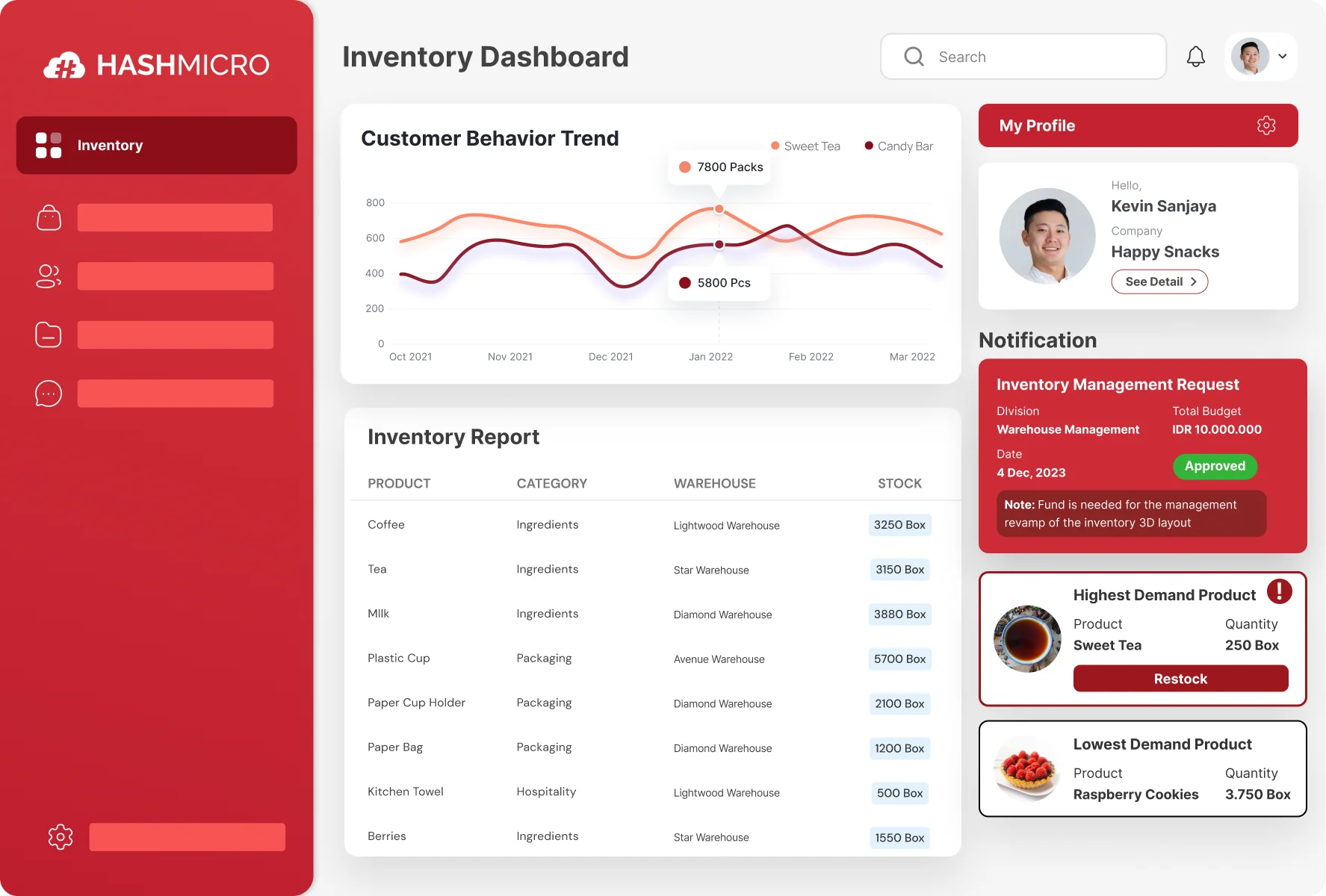Imagine managing your warehouse or retail inventory without an integrated process, where each location updates stock records manually. This often results in data discrepancies, operational delays, and unnecessary expenses. For businesses, this inefficiency has a direct impact on profits and long-term growth.
The Philippine retail sector reached a market value of around ₱2.37 trillion in 2025 and is projected to grow steadily through 2030. This expansion, driven by multi-channel selling and increased consumer demand, puts more pressure on businesses to maintain stock accuracy across all locations.
To address this, businesses should use inventory management software that unifies stock data and updates it in real time. With the right system, they can spot discrepancies early, balance stock levels, and make better decisions quickly.
In this article, we will explore what inventory discrepancies are, why they happen, and how to prevent them using the right tools and strategies. This guide is built for business owners who gusto mong mapabuti ang kawastuhan ng imbentaryo at magmaneho ng pang-matagalang paglago.
Key Takeaways
|
Table of Contents
What is an Inventory Discrepancy?
An inventory discrepancy is a condition where the stock quantity recorded in your system does not match the actual physical count in your warehouse. This issue often reflects underlying warehouse challenges that may affect stock accuracy, order fulfillment, and overall inventory management.
Even a small error in inventory can create big problems. You might think you have enough items to fulfill orders, only to discover you’re out of stock. On the other hand, you could end up overstocking items you thought were missing. Both scenarios lead to inefficiency, added costs, and lost revenue.
Just like a single misstep can disrupt the entire supply chain, one inventory discrepancy can ripple through your business operations. Before jumping into how to resolve it, it’s important to first understand the different types and the common causes behind these inconsistencies.
Types of Inventory Discrepancy
Inventory discrepancies can be categorized into various forms based on how they arise. Each type can reveal fundamental problems in operations, system usage, or staff procedures. Common types include:
1. Inaccurate stock quantities
This refers to a situation where the numbers in your system don’t match the actual inventory. It affects production and fulfillment because materials or items are assumed to be available. The issue typically stems from inaccurate receiving, manual miscounts, or outdated entries.
2. Unexpected stock shortages
A stockout happens when the system says stock is available, but it’s not on the shelf. This usually surfaces after you’ve confirmed an order but can’t fulfill it. Poor integration between systems or unrecorded stock movements are often the cause.
3. Overstocks and inactive inventory
Overstocking happens when you order more than needed due to inaccurate forecasts. Dead inventory refers to goods that stay unsold and take up warehouse space. Both reduce cash flow, force markdowns, and harm long-term profit margins.
4. Items lost within the warehouse
Inventory may exist, but it can’t be found due to poor tracking or unregistered location changes. Staff waste time looking for items, delaying fulfillment, and disrupting workflows. This often results from disorganized storage layouts or labeling errors.
5. Mistakes during shipping
Discrepancies also occur when the wrong quantity or item is shipped out or replaced. If damaged products are substituted without updating records, stock becomes unreliable. These mistakes increase costs, complicate returns, and lower customer confidence.
The right system helps you manage all types of inventory discrepancies with ease. Gain better control, faster order fulfillment, and accurate stock tracking. Click here to see how HashMicro simplifies everything.
Causes of Discrepancy in Inventory
Inventory discrepancies don’t happen by accident. They are often the result of weak internal controls, lack of coordination, or miscommunication between departments. Understanding these root causes helps businesses take preventive action early on.
1. Manual human errors
Simple mistakes in data entry, counting, or item tagging can distort inventory records. These errors usually occur during receiving, picking, or stocktaking. Even one miskeyed number can trigger a chain of inaccurate reports and wrong decisions.
2. Loss through theft or damage
Internal theft, product loss, or damaged goods that are not immediately recorded can reduce stock levels. When these losses go unnoticed or undocumented, the system continues to show incorrect quantities. This silently affects profitability and stock planning.
3. Disorganized warehouse setup
A chaotic warehouse layout makes it hard for staff to locate or store items accurately. Without proper labeling or staff training, products are easily misplaced or counted incorrectly. This causes delays in operations and unreliable inventory figures.
4. Lack of system integration
Disconnected systems between inventory, sales, purchasing, or accounting lead to gaps in data flow. Without real-time syncing, updates from one department may not reflect elsewhere. This misalignment results in duplicate orders or unbalanced stock reports.
5. Incomplete or delayed documentation
Every stock movement, return, or adjustment must be logged promptly and correctly. When documentation is missed or postponed, inventory records become outdated. This affects audits, reporting accuracy, and daily operational decisions.
The Impact of Inventory Discrepancies
Ignoring inventory discrepancies can lead to significant operational and financial setbacks. Business owners must be aware of these consequences and their long-term effects. Here are the main impacts:
- Declining customer satisfaction: When orders can’t be fulfilled as promised, customers lose trust. Repeated issues may cause them to turn to competitors permanently.
- Distorted financial reporting: Inaccurate stock affects valuation and profit margins. It also creates problems in audits and leads to misleading financial insights.
- Drops in operational productivity: Time is wasted searching for missing or mislabeled stock. This reduces warehouse efficiency and delays fulfillment schedules.
- Missed revenue opportunities: You may lose sales due to stockouts or tie up capital in unsold goods. Either way, profitability takes a hit over time.
- Unreliable business decisions: Bad inventory data misleads procurement and forecasting. This results in overstocking, shortages, or missed market demand.
How to Find Inventory Discrepancies?
Detecting discrepancies early helps minimize disruptions. Businesses can identify mismatches using systematic approaches that combine technology and best practices. These include:
1. Perform visual inspections
Walking around the warehouse to visually inspect stock conditions can reveal obvious problems. Although technology-based systems are sophisticated, this manual step helps detect obvious errors and items stored in the wrong place before they become bigger problems.
2. Perform sample checks and cycle counts
This method involves counting a small sample of inventory and comparing it to system data. Conducted randomly or on a scheduled basis, this method provides a quick audit of accuracy and identifies inefficiencies in the inventory management process.
3. Schedule routine inventory audits
A full inventory audit, though timely, is crucial for gaining a comprehensive view of inventory health. These audits are typically conducted annually or quarterly and involve manually counting each item to uncover significant discrepancies and process gaps.
4. Why inventory counting matters
- Improve inventory accuracy: Align physical inventory with system records to reduce discrepancies.
- Reduce the risk of loss: Identify theft, damage, and loss early on before it piles up.
- Ensure better shipping: Help avoid stockouts so customers receive accurate and timely deliveries.
- Support smarter inventory control: Enable trend tracking, demand forecasting, and better inventory planning.
How to Prevent Inventory Discrepancies
Preventing inventory discrepancies requires consistent practices and regular checks. Here are some ways to ensure stock data accuracy:
1. Visual inspection
Conduct regular physical inspections in storage areas. This step is important for detecting damage or misplacement of goods. Even though the system is digital, direct checking remains crucial.
2. Spot-checking or cycle counting
Randomly count a portion of the inventory and compare it with system data. This method is suitable for quickly assessing inventory management accuracy. It can be done without interrupting the entire operational process.
3. Schedule a full inventory audit
Periodic audits involve counting all inventory across all locations. Although resource-intensive, these audits provide a comprehensive accuracy check. Audit results can reveal deeper process or system issues that need to be addressed.
Improve Stock Control Through HashMicro Inventory Software 
Inventory discrepancies can silently reduce your profits, disrupt workflows, and damage customer trust. To prevent these challenges, businesses need a system that ensures real-time accuracy, transparent tracking, and proactive inventory control. HashMicro Inventory Management Software is designed to do exactly that.
As one of the most trusted cloud-based inventory solutions in Southeast Asia, HashMicro empowers businesses in the Philippines to manage stock seamlessly across multiple locations. The system helps prevent stock mismatches, reduce losses, and improve audit readiness, all from a centralized, easy-to-use platform.
More than the capabilities already covered above, the HashMicro Inventory Management Software brings even more powerful features.
- Hashy AI: uses an intelligent assistant with a chat box that helps monitor inventory levels, alerts you to low or expiring stock, and recommends restocking. It automates PR submissions, tracks status, and manages internal transfers in seconds. This reduces manual errors and prevents inventory discrepancies.
- Barcode Management: Ensure every item is accounted for with accurate barcode scanning. This feature helps track stock movement clearly and minimizes manual entry errors that often cause inventory discrepancies.
- Lot and Serial Number Tracking: Automatically generate and track lot and serial numbers to maintain complete traceability. This reduces confusion in stock rotation and avoids mistakes during receiving or picking processes.
- Stock Request Management: Automate internal stock request workflows to avoid missing or duplicated requests. This ensures that inventory updates are timely and consistent across departments, minimizing data mismatch.
- Inventory Forecasting: Predict future stock needs based on historical data and trends. Forecasting helps prevent both overstocking and stockouts, two major causes of inventory inconsistencies.
- Inventory Valuation: Get real-time visibility on inventory value across all storage points. Accurate valuation ensures your financial records reflect the true state of your stock, supporting cleaner audits and smarter decisions.
- Stock Aging Analysis: Monitor how long items stay in storage and act before they expire or become obsolete. This helps reduce waste, write-offs, and unrecorded losses that often go unnoticed in outdated systems.
Conclusion
Inventory discrepancies occur when there is a mismatch between recorded stock and actual stock, which disrupts business operations and reduces profitability. Identifying and addressing these gaps is critical to ensuring smooth workflows and accurate reporting.
With HashMicro’s Inventory Management Software, businesses in the Philippines can monitor stock levels in real time, detect discrepancies earlier, and streamline inventory processes from a centralized system. This software helps improve accuracy, reduce losses, and support growth.
Discover how HashMicro can help you eliminate costly inventory errors. Try our free demo today and experience paano naghahatid ang automation ng mas mahusay na kontrol, mas matalinong pagpaplano, and improved warehouse efficiency.
Question About Inventory Discrepancy
-
How to record inventory discrepancy?
Inventory discrepancies should be recorded by comparing physical stock counts with system data. Any difference must be documented in an inventory adjustment form, noting the item, quantity difference, reason, and responsible personnel.
-
How to report inventory discrepancy?
Discrepancies are typically reported through internal stock reports or inventory discrepancy reports. The report should include item codes, expected versus actual quantities, location, and potential causes, then submitted to management or inventory control.
-
What is KPI inventory discrepancy?
Inventory discrepancy KPI measures the percentage of mismatched items between actual and recorded stock. It helps businesses track stock accuracy and warehouse performance. A lower percentage reflects better inventory control and system reliability.
-
How to calculate inventory discrepancy?
To calculate inventory discrepancy, subtract the physical stock from the recorded quantity in the system. A positive result indicates overstock, while a negative result shows a shortage. Regular cycle counts help monitor and update these gaps.
























